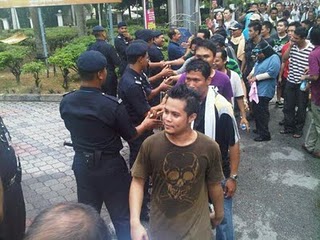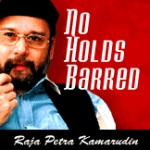
Anwar: I was just walking along, minding my own business (photo from malaysiakini.com)
Crackdown lowered rally numbers but made Malaysian government look bad
Although Prime Minister Najib Tun Razak appears to have won the
battle by closing down Kuala Lumpur on Saturday and arresting 1,667
mostly peaceful marchers and would-be marchers, the consensus seems to
be that Malaysia has suffered a blow to its international reputation as a
moderate, democratic country.
Bersih 2.0, as the Coalition for Clean and Fair Elections is known,
appears to have won on points. a wan-lookng Opposition Leader Anwar
Ibrahim, the head of the three-party Pakatan Rakyat, was photographed in
his hospital bed where he was kept for observation, a neat coup de
theatre whether intended or not.
While it didn't draw anywhere close to the 100,000 people Bersih's
leaders forecast, they can claim that the police intimidation kept
marchers away. Crowd estimates ranged from 10,000 by the government to
50,000 by Bersih. Pictures of marchers being chased by baton-wielding
police and hosed down by water cannon have made most of the world's
major newspapers and the story was given prominent on-line coverage by
Al Jazeera. Despite the fact that Bersih is an umbrella group of 62
non-government organizations, with a great many Chinese and Indian faces
rather than Muslim ones, the march has been tied internationally to the
Jasmine Revolutions of the Middle East, with at least one blog -- Time
Magazine's Hannah Beech -- even alluding to opposition leaders hoping
for the smell of jasmine.
The crackdown, which included razor wire strung at strategic entry
points to the city, legions of police, tear gas, water cannon and
truncheons, is especially embarrassing given Malaysia's membership on
the United Nations Human Rights Council. To prove it is supported by the
electorate, however, the government has promised a massive
counter-rally that will draw hundreds of thousands of supporters, which
probably will not be accompanied by water cannons, truncheons, tear gas,
razor wire and legions of police intended to keep marchers away.
The Barisan Nasional, the ruling national coalition, characterized the
Bersih 2.0 march as a tool of the opposition Pakatan Rakyat coalition,
and indeed top Pakatan leaders did show up and were duly arrested. It
also alleged that the US was behind a plot to destabilize the country
through the National Endowment for Democracy, which gives money to
Bersih. The NED is a private, non-profit foundation funded by the US
Congress whose ostensible aim is to support democratic goals.
Often the government's tactics seemed a puzzling throwback to previous
arguments. In the run-up to the march itself, police arrested 30 members
of the Malaysian Socialist Party on June 26 and charged them with
seeking to overthrow the country's monarchy and make a hero of Chin
Peng, the elderly one-time leader of the Communist insurgency against
British Malaya who remains in exile. Last week, police held a press
conference to announce they had found caches of machetes and Molotov
cocktails secreted around Kuala Lumpur along with yellow Bersih
tee-shirts, leaving the question open why Bersih members would leave the
shirts with the weapons to identify them as violent when they professed
to be peaceful marchers. The caches of weapons were mostly dismissed as
a dirty trick.
"I think it has tarnished Malaysia's image and its membership in the UN
Human Rights Council," political analyst Khoo Kay Peng told
Agence-France Press. Describing the police action as "completely
overdone," Khoo said, "It is a killer to our image as a progressive
democratic country."
Beyond the question of who won or lost, the massive police crackdown
raises the question why the ruling coalition reacted so strongly. The
answer goes back to 2007, when the first Bersih rally drew 40,000
protesters, one of the biggest in modern Malaysian history, and
engendered the same kind of crackdown by the government of then-Prime
Minister Abdullah Ahmad Badawi.
That rally was widely regarded as the spur that ultimately drove the
Anwar-led coalition to victory in five Malaysian states and broke the
Barisan?s 50-year-old two-thirds parliamentary majority. Although
opinion polls show Najib himself as popular with the electorate, the
three political parties that make up the bulk of the ruling coalition --
the United Malays National Organization, the Malaysian Chinese
Association and the Malaysian Indian Congress -- all are regarded as
corrupt by segments of the electorate. The Chinese in particular have
abandoned the Barisan.
With an election expected to be called sometime before the middle of
2012, Najib and the Barisan believe Pakatan Rakyat would be able to gain
traction out of the protest, as it did in 2008.
Bersih argues that the Barisan is kept in power by electoral laws that
create an unfair advantage. In particular, according to Bersih Steering
Committee member Wong Chin Huat, 2.5 million young people are being kept
off the electoral rolls at the same time many more ghost voters are
being kept on the rolls.
The eight-point demands that Bersih had hoped to present to the king
include cleaning the electoral rolls, reforming the postal ballots and
marking voters with indelible ink to discourage repeat voters.
The organization also called for a minimum 21-day campaign period,
complaining that the government can put its electoral machinery in place
before the opposition has the chance to gear up. In one election, Wong
told Asia Sentinel, only eight days elapsed between the dissolution of
parliament and the polls.
With all of the conventional media -- newspapers, radio and television
-- in the hands of the major political parties, Bersih is also asking
for "free and fair access to the media," Although the opposition parties
have their own press, it is subject to licensing by the government and
can only be distributed to party members.
The press has become a potent issue, with seemingly hundreds of bloggers
on the scene whose barbs are believed to have played a major role in
the 2008 national elections. The government has periodically threatened
to pass legislation to license Internet journalism, but has backed away.
Wong, however, said that Internet journalists are unable to reach the
rural Malay villages that form the bulk of UMNO's support.
One UMNO stalwart, however, denied that election reform is necessary,
saying the fact that the opposition won five states in the 2008
elections is an indication that elections are already free and fair.
In any case, it's pretty sure that electoral reform is not going to
happen. The Barisan maintains a strong hold on parliament and the
chances of reform legislation passing are nil. Najib, in a triumphal
press conference on Sunday, however, said the government is introducing
its own election reforms including putting a biometric system in place.


 I
bumped into several friends along the way – a CEO of a trading company,
a senior insurance agency manager and the head of a company secretarial
services firm. They told me it was the first time they were joining any
form of public protest or demonstration.
I
bumped into several friends along the way – a CEO of a trading company,
a senior insurance agency manager and the head of a company secretarial
services firm. They told me it was the first time they were joining any
form of public protest or demonstration.  The second key lesson of July 9 is that the race-baiting by Perkasa and its ilk, and incendiary reporting by Utusan Malaysia, appears to have fallen on deaf ears, at least for the people in the Klang Valley.
The second key lesson of July 9 is that the race-baiting by Perkasa and its ilk, and incendiary reporting by Utusan Malaysia, appears to have fallen on deaf ears, at least for the people in the Klang Valley. 








 The
party's vice president N Surendran said that the victims of this attack
included Opposition leader Anwar Ibrahim and his spouse Dr Wan Azizah
Wan Ismail, DAP strongman Lim Kit Siang, and PAS president Abdul Hadi
Awang.
The
party's vice president N Surendran said that the victims of this attack
included Opposition leader Anwar Ibrahim and his spouse Dr Wan Azizah
Wan Ismail, DAP strongman Lim Kit Siang, and PAS president Abdul Hadi
Awang. "PKR vice-chief and Batu MP Tian Chua then walked towards the police line to negotiate," he added.
"PKR vice-chief and Batu MP Tian Chua then walked towards the police line to negotiate," he added. According to a Malaysiakini journalist on site, the city's main transit point was a scene of
According to a Malaysiakini journalist on site, the city's main transit point was a scene of  It
is learnt that during the chaos, journalists were blocked from entering
the area after the cannisters were shot, and no one knew what was
happening inside in the underpass.
It
is learnt that during the chaos, journalists were blocked from entering
the area after the cannisters were shot, and no one knew what was
happening inside in the underpass. The attack injured Anwar, his bodyguard Fayadh Al-Bakri and PAS Shah Alam MP Khalid Samad, reported Surendran.
The attack injured Anwar, his bodyguard Fayadh Al-Bakri and PAS Shah Alam MP Khalid Samad, reported Surendran. Surendran
said it should be noted that police deliberately ignored attempts to
communicate with the group, while there were no warning, time limit or
dispersal order given to the crowd.
Surendran
said it should be noted that police deliberately ignored attempts to
communicate with the group, while there were no warning, time limit or
dispersal order given to the crowd.
 MIC
president G Palanivel said many in the Indian community realised that
yesterday's illegal rally held in the federal capital was not actually
about questioning the role of the Election Commission.
MIC
president G Palanivel said many in the Indian community realised that
yesterday's illegal rally held in the federal capital was not actually
about questioning the role of the Election Commission. Palanivel
said the realisation came about after proactive measures taken by the
government that focused on improving the lot of the Indian community.
Palanivel
said the realisation came about after proactive measures taken by the
government that focused on improving the lot of the Indian community. Palanivel said yesterday's Bersih-organised illegal rally also clearly
Palanivel said yesterday's Bersih-organised illegal rally also clearly


